Hilliardiella flanaganii
Hilliardiella flanaganii (E.Phillips) H.Rob., Skvarla & V.A.Funk
Family: Asteraceae
Common names: Drakensberg vernonia (Eng.)
Introduction
Hilliardiella flanaganii, commonly known as Drakensberg vernonia, is a strikingly beautiful perennial herb with annual stems from a woody rootstock, attractive leaves and showy purple flowers in summer.
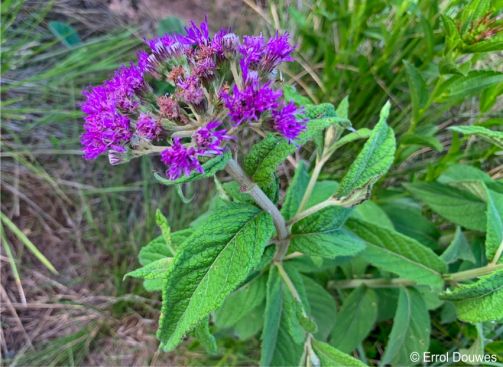
Description
Description
Hilliardiella flanaganii is an herbaceous perennial, about 1 m tall. Leaves with short stalks, egg-shaped leaflets, margins slightly toothed, upper and lower leaf surface gland-dotted, sparsely covered with hair on the upper surface and densely hair-covered below.
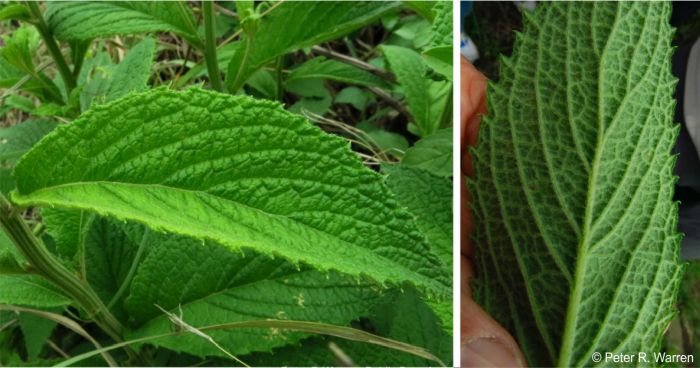
Flowers are purple, in rounded, large, flowerheads. Florets tubular, corolla gland-dotted with regular T-shaped hairs, blooming in early to midsummer, from October to January. Style branched and anthers arrowhead-shaped with egg-shaped apical appendages. Fruit almost round, ribbed, densely sericeous and gland dotted, with a white bi-seriate pappus.
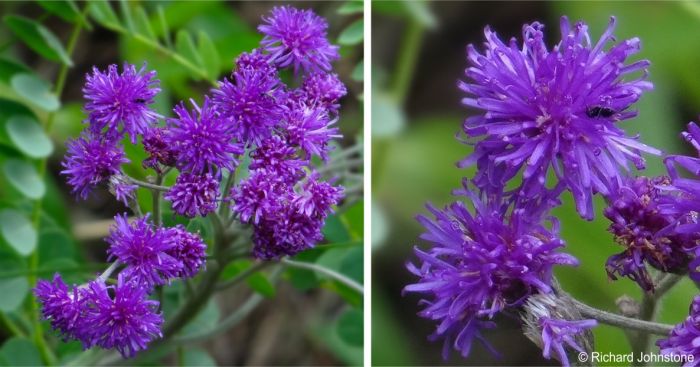
Hilliardiella flanaganii is distinguished by the wedge-shaped base of the leaf that tapers into a short leafstalk and larger flower heads with longer, lance-like involucral bracts, growing into a long sharp tip, exceeding the pappus.
Conservation Status
Status
Hilliardiella flanaganii is assessed as Least Concern (LC) in the Red List of South African Plants.
Distribution and habitat
Distribution description
Hilliardiella flanaganii is endemic to South Africa. It occurs in the Drakensberg region, in KwaZulu-Natal and the eastern part of the Free State. It grows in moist scrubby places, on damp grassy slopes, and below cliffs. Hilliardiella flanaganii is typically found on high mountain slopes and in sunny habitats.
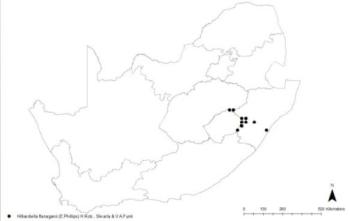
Derivation of name and historical aspects
History
Vernonieae is commonly called the ‘evil tribe’ by botanists because of overlapping characters, making its taxonomy difficult. In Africa the Vernonieae group is divided into smaller groups with Hilliardiella recognised as separate genus in subtribe Centralpinae. The name Hilliardiella is derived from the subsectional name given by Jones in 1981, and the name is specified by Jones to honour the South African botanist Dr Olive Mary Hilliard, a student of the daisy family, particularly those of KwaZulu-Natal. Hilliardiella is closely related to Cyanthillium but differs in certain characteristics, such as perennial habit and T-shaped hairs of the corolla. Hilliardiella flanaganii was previously known as Vernonia flanaganii (E.Phillips) Hilliard and Vernonia hirsuta var. flanaganii E.P. Phillips. The species is named after Henry George Flanagan (1861–1919), a South African farmer and plant collector, who collected the type specimen.
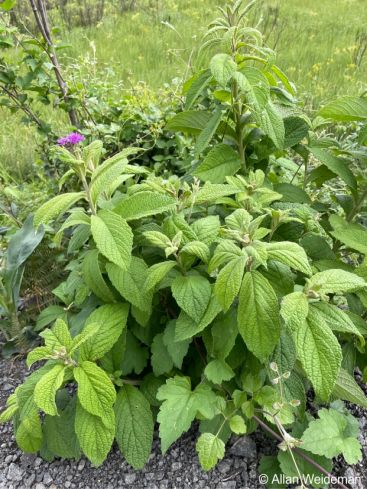
Ecology
Ecology
Hilliardiella species have bright, colourful flowers ranging from mauve and violet to purple. They attract many insects, especially bees and butterflies. Hilliardiella species, including H. flanaganii, are characterised by seeds with a white pappus and are dispersed by wind. The plants of Hilliardiella thrive during summer and lie dormant in winter.
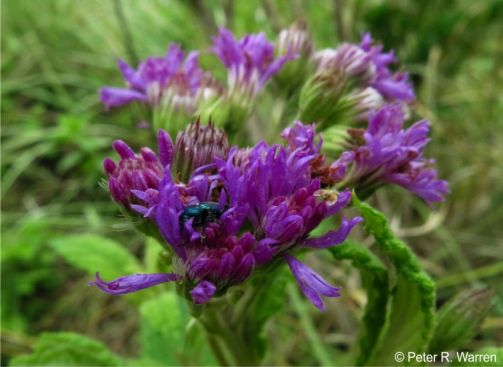
Uses
Use
Plants of Hilliardiella are known to be useful in treating ailments such as sores and wounds by applying a powder made from the leaf or stem. Hilliardiella flanaganii is similar to Hilliardiella hirsuta, which is traditionally used to treat colic, sore throats, headaches, rashes, and coughs.
Growing Hilliardiella flanaganii
Grow
Hilliardiella flanaganii is not known in cultivation and there are no specific methods reported for its propagation. However, species of Hilliardiella can be propagated through seeds and cuttings and we recommend using the general techniques used for closely related species such as H. hirsuta, H. oligocephala and H. aristata as a guide. Species of Hilliardiella grow easily from tip cuttings taken from new growth in spring and early summer and seeds sown in spring or summer. The plants prefer warm, sunny conditions with well-drained, fertile soil and plenty of water in summer to grow successfully.
References
- Douwes, E. 2021. Observation of Hilliardiella flanaganii, Uthukela, KwaZulu-Natal. iNaturalist. Online. https://www.inaturalist.org/observations/101254062.
- Glen, H.F. & Germishuizen, G. (compilers). 2010. Botanical exploration of southern Africa, edition 2. Strelitzia 26. South African National Biodiversity Institute, Pretoria.
- Johnstone, R. 2014. Observation of Hilliardiella flanaganii, Giants Castle Game Reserve, KZN. iNaturalist. Online. https://www.inaturalist.org/observations/148399969.
- Jones, S.B. 1981. Synoptic classification and pollen morphology of Vernonia (Compositae: Vernonieae) in the old world. Rhodora 83(833):59-75.
- Keeley, S.C., et al. 2007. A phylogeny of the evil tribe (Vernonieae: Compositae) reveals old/new world long distance dispersal: support from separate and combined congruent datasets (trnL-F, ndhF, ITS). Molecular Phylogenetics and Evolution 44(1):89-103.
- Leistner, O.A. (ed.). 2000. Seed plants of southern Africa: families and genera. Strelitzia 10. National Botanical Institute, Pretoria.
- Mbhele, N. 2021. Ethnobotanical survey, pharmacological evaluation and chemical characterization of selected medicinal plants used in South Africa in the management of wounds. Doctoral Thesis, University of Johannesburg, Johannesburg.
- Pooley, E. 1998. A field guide to wild flowers of Kwazulu-Natal and the eastern region. Natal Flora Publications Trust, Durban.
- Raimondo, D., Von Staden, L., Foden, W., Victor, J.E., Helme, N.A., Turner, R.C., Kamundi, D.A. & Manyama, P.A. (eds) 2009. Red list of South African plants. Strelitzia 25. South African National Biodiversity Institute, Pretoria.
- Robinson, H., Skvarla, J.J. & Funk, V.A. 2016. Vernonieae (Asteraceae) of southern Africa: A generic disposition of the species and a study of their pollen. PhytoKeys 60:49-126.
- Robinson, H. 1999. Revisions in paleotropical Vernonieae (Asteraceae). Proceedings of the Biological Society of Washington 112: 220–247.
- Swelankomo, N., Manning, J.C. & Magee, A.R. 2016. The genus Hilliardiella (Asteraceae: Vernonieae) in southern Africa. South African Journal of Botany 106:41-59.
- Warren, P. 2013. Observation of Hilliardiella flanaganii, Cavern, KZN. iNaturalist. Online. https://www.inaturalist.org/observations/10912394.
- Weideman, A. 2021. Observation of Hilliardiella flanaganii, Giants Castle Game Reserve, KZN. iNaturalist. Online. https://www.inaturalist.org/observations/103423200.
Credits
Mbali Mkhize and Thuli Dlamini
National Herbarium, Pretoria
July 2025
Acknowledgements: Images used were provided by Errol Douwes, Peter Warren, Richard Johnstone and Allan Weideman via iNaturalist. The authors thank them for making their images freely available for educational and research purposes.
Plant Attributes:
Plant Type: Perennial
SA Distribution: Free State, KwaZulu-Natal
Soil type: Loam
Flowering season: Early Summer
PH: Acid, Neutral
Flower colour: Purple
Aspect: Full Sun
Gardening skill: Average
Special Features:
Horticultural zones
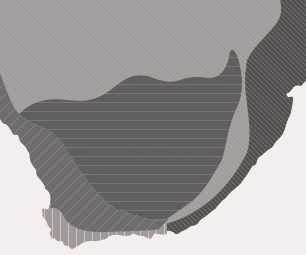






Rate this article
Article well written and informative
Rate this plant
Is this an interesting plant?
Login to add your Comment
Back to topNot registered yet? Click here to register.